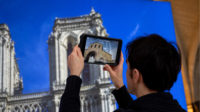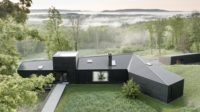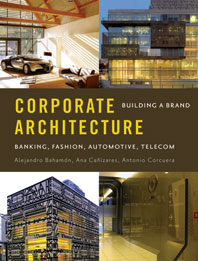Built in 1907 on the left bank of the Seine, the Docks de Paris is a narrow, 525-foot-long former depot for goods brought up the river by barge. It was also one of Paris’s first reinforced-concrete buildings, lending it historical significance despite its neglected state and somewhat nondescript, utilitarian design. So when the Paris-based firm Jakob + MacFarlane won the competition to transform it into a new fashion and design center, “We chose to conserve the structure, take it right back to the skeleton, and propose a new skin,” says Brendan MacFarlane, the firm’s principal with Dominique Jakob. “It created an opportunity to give a new face to a faceless building.”
The “new face” would take the form of what the architects call the “Plug-Over”—a structure that wraps over the top of the building, appearing as a warped and faceted protuberance of green-fritted glass that snakes across its river-facing facade. Housing a new staircase providing vertical circulation, it links the building’s original three floors while morphing into a spectacular new rooftop level of undulating, landscaped, and oak-decked surfaces.
What’s more, as part of a broader redevelopment strategy, Docks de Paris was seen “as a new gateway into the 13th arrondissement,” MacFarlane says. Abutting the Quai d’Austerlitz, and connecting new river-bus and water-taxi stops to the higher street level, the 170,000-square-foot project is located just to the east of the Pont Charles de Gaulle bridge as the latter leads toward the Gare d’Austerlitz train station. “The views of the facade from the water and bridge were quite important,” the architect says.
To start with, MacFarlane stripped the building—which over the years housed everything from “an exotic Hawaiian nightclub” to “places selling cheap carpets”—to its bare bones. (Retaining the existing frame also served an environmental, waste-reducing purpose.) What was left was sandblasted, leaving a grid of raw concrete within which new perimeter glazing and facades would be installed. Meanwhile, the program, labeled the City of Fashion and Design, called for shops, cafés, and studios alongside a rooftop restaurant, a 43,000-square-foot exhibition space, and a new home for the prestigious Institut Français de la Mode fashion school at the building’s western end, which opened last December.
Tying everything together is the Plug-Over. Evoking the Seine, the wavelike addition was both the project’s signature feature and its greatest challenge. To derive its form, the architects began by dividing the building’s repeating chain of four 25-foot bays separated by a single 33-foot bay into increments of 8 feet each. They then extrapolated this applied grid into an “arborescent” system that “creates a volumetric deformation from the existing geometry of the building,” MacFarlane says, adding that the site’s zoning envelope also informed the Plug-Over’s shape.
With its overall form determined, a way of attaching the new 330-ton addition to the original structure had to be devised. On the one hand, the structure was quite sturdy, having been designed for loads of 190 pounds per square foot. On the other, its smooth, mild-steel rebars and some fragile column-beam connections posed weaknesses. “The question was how to load up the building without necessitating huge interventions on the concrete,” says Mitsu Edwards, a director at RFR, the project’s engineer.
The solution lay in installing the Plug-Over as a sequence of vertical slices—a series of portal frames (picture warped Ds and Bs) constructed of 6.6-inch-diameter steel tubes that are hung, at Jakob + MacFarlane’s 8-foot intervals, off the building’s newly rebuilt top edge beam. With its vertical load thus distributed, the Plug-Over’s lateral wind and dead loads could then bear horizontally against the lower floor plates.
The other challenge came from the geometry of the Plug-Over itself. Because the ends of the portal arches—the Ds and Bs—naturally want to spread out, vertical steel support tubes help maintain their curvature, acting in tension like the cord of an archer’s bow. Smaller, 4-inch-diameter steel tubes were added along the length for longitudinal stability, while wind trusses were also incorporated at the bottom.
Meanwhile, ensuring that all 630 glass panels were planar and fit together required considerable tweaking of the parametric modeling. Keeping the panels flat was not only a design prerogative, but also a cost-cutting measure. “The trickiest part of the project was retaining its architectural ambition within what was a very tight budget,” says Edwards. To further reduce costs, the double-laminated panels are held in place along the top and bottom only, rather than on all four sides, while their thicknesses were allowed to vary between 0.5 and 1 inch; any resulting color variations were mitigated by, among other things, the green frit.
To be sure, getting everything right was a delicate dance. Yet the result is a dynamic example of adaptive reuse that “takes the industrial history of an existing structure and proposes something into the future,” MacFarlane says. “It was a structure ready to take more building, and that’s what we gave it.”












